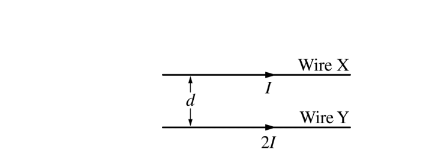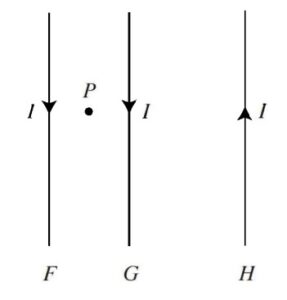Question

Two long, straight parallel wires X and Y are separated by a distance d and carry currents I and 2I, as shown in the figure above. The force on wire X has magnitude F. If the current in each wire is both doubled and reversed in direction, which of the following is true of the magnitude and direction of the new force on wire X?
Magnitude Direction
(A) F Unchanged
(B) 2F Reversed
(C) 2F Unchanged
(D) 4F Reversed
(E) 4F Unchanged
Answer/Explanation
Question

Three long wires, R, S, and T, are in the positions and carrying the currents indicated in the figure above. All currents are in the plane of the page and in the direction indicated. What are the magnitude and direction of the magnetic field at the origin?
Magnitude Direction
(A)\(\frac{\mu _{0}I}{\pi}\) Into the page
(B)\(\frac{\mu _{0}I}{\pi}\) Out of the page
(C)\(\frac{2\mu _{0}I}{\pi } \) Into the page
(D)\(\frac{2\mu _{0}I}{\pi} \) Out of the page
(E)\(\frac{4\mu _{0}I}{\pi }\) Out of the page
Answer/Explanation
Question

A piece of metal in the plane of the page is connected in a circuit as shown above, causing electrons to move through the metal to the left. The piece of metal is in a magnetic field B directed out of
the page. X and Y are points on the edge of the metal. Which of the following statements is true?
(A) The current will decrease to zero due to the magnetic field.
(B) The potentials at X and Y are equal.
(C) X is at a higher potential than Y.
(D) Y is at a higher potential than X.
(E) The current will increase exponentially due to the magnetic field.
Answer/Explanation
Ans: C
Question

Three parallel wires, F, G, and H, all carry equal current I, in the directions shown above. Wire G is closer to wire F than to wire H. The magnetic field at point P is directed
(A) into the page
(B) out of the page
(C) to the left
(D) to the right
(E) toward the top of the page
Answer/Explanation
Ans: B
Use the right-hand rule to determine the direction of the magnetic field due to each wire. The magnetic fields due to F and G cancel because the one due to F is out of the page at
Question

A dipole molecule is traveling into the plane of the page through a uniform magnetic field directed to the right. Which of the following arrangements of the dipole would result in o net force,
but a non-zero net torque?
(A) 
(B) 
(C) 
(D) All of the above
(E) None of the above
Answer/Explanation
Ans: C
Use the right hand rule on each half of the dipole. For each answer choice, the resulting magnetic forces would be

